What is Compound Nucleus and what is Resonance?
There is no difference between the compound nucleus and the nuclear resonance.
The compound nucleus is the intermediate state formed in a compound nucleus reaction. It is normally one of the excited states of the nucleus formed by the combination of the incident particle and target nucleus. Suppose a target nucleus X is bombarded with particles a. In that case, it is sometimes observed that the ensuing nuclear reaction takes place with appreciable probability only if the particle’s energy is in the neighborhood of certain definite energy values. These energy values are referred to as resonance energies. The compound nuclei of these certain energies are referred to as nuclear resonances. Resonances are usually found only at relatively low energies of the projectile. The widths of the resonances increase in general with increasing energies. At higher energies, the widths may reach the order of the distances between resonances, and then no resonances can be observed. The narrowest resonances are usually the compound states of heavy nuclei (such as fissionable nuclei) and thermal neutrons (usually in (n,γ) capture reactions). The observation of resonances is by no means restricted to neutron nuclear reactions.
Resonances and Neutron Cross-section
For the compound nucleus, peaks in the cross-section are typical. Each peak manifests a particular compound state of the nucleus. These peaks and the associated compound nuclei are usually called resonances. The behavior of the cross-section between two resonances is usually strongly affected by the effect of nearby resonances.
Resonances (particular compound states) are mostly created in neutron nuclear reactions, but it is restricted to neutron nuclear reactions. The quantum nature of nuclear forces causes the formation of resonances. Each nuclear reaction is a transition between different quantum discrete states or energy levels. The discrete nature of energy transitions plays a key role. Suppose the energy of the projectile (the sum of the Q value and the kinetic energy of the projectile) and the energy of the target nucleus are equal to a compound nucleus at one of the excitation states. In that case, a resonance can be created, and a peak occurs in the cross-section. The allowable state density in this energy region is much lower for the light nucleus, and the “distance” between states is higher. For heavy nuclei, such as 238U, we can observe a large resonance region in the neutron absorption cross-section.
The compound states (resonances) are observed at low excitation energies. This is due to the fact, the energy gap between the states is large. At high excitation energy, the gap between two compound states is very small, and the widths of resonances may reach the order of the distances between resonances. Therefore, no resonances can be observed at high energies, and the cross-section in this energy region is continuous and smooth.
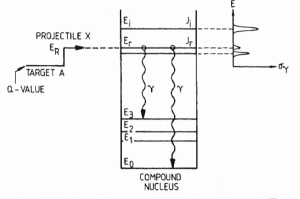
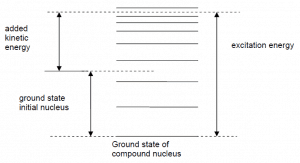 Energy levels of compound state. For neutron absorption reaction on 238U the first resonance E1 corresponds to the excitation energy of 6.67eV. E0 is a base state of 239U.
Energy levels of compound state. For neutron absorption reaction on 238U the first resonance E1 corresponds to the excitation energy of 6.67eV. E0 is a base state of 239U.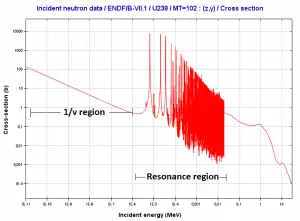 Region of resonances of 238U nuclei.
Region of resonances of 238U nuclei.
Source: JANIS (Java-based Nuclear Data Information Software); The ENDF/B-VII.1 Nuclear Data Library
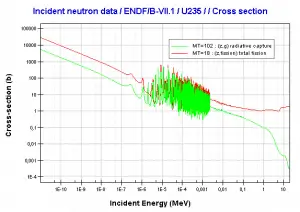 Uranium 235. Comparison of total fission cross-section and cross-section for radiative capture.
Uranium 235. Comparison of total fission cross-section and cross-section for radiative capture.
Source: JANIS (Java-based Nuclear Data Information Software); The ENDF/B-VII.1 Nuclear Data Library
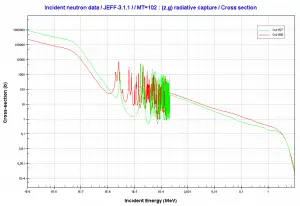 Gadolinium 155 and 157. Comparison of radiative capture cross-sections. Both nuclei have region of resonances.
Gadolinium 155 and 157. Comparison of radiative capture cross-sections. Both nuclei have region of resonances.
Source: JANIS (Java-based Nuclear Data Information Software); The JEFF-3.1.1 Nuclear Data Library
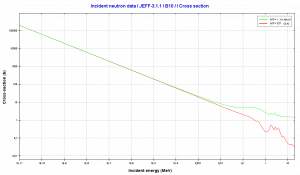 Boron 10. Comparison of total cross-section and cross-section for (n,alpha) reactions.Isotope 10B does not have any region of resonances.
Boron 10. Comparison of total cross-section and cross-section for (n,alpha) reactions.Isotope 10B does not have any region of resonances.
Source: JANIS (Java-based Nuclear Data Information Software); The JEFF-3.1.1 Nuclear Data Library